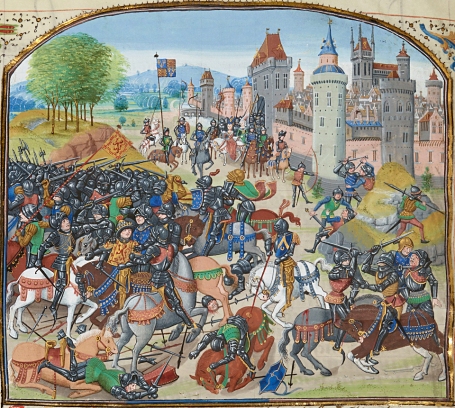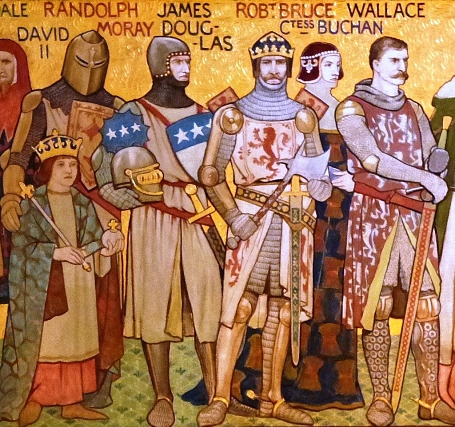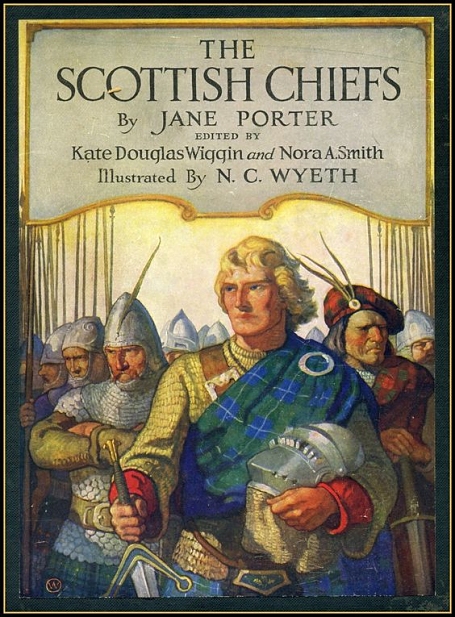The Life and Heroick Actions of the Renoun'd Sir William Wallace,
General and Governour of Scotland
by William Hamilton of Gilbertfield
Book X, Chapter IV (Continued)
How Sir William Douglas won the Castle of Sanquhair by a Jeopardie: How WALLACE rescu'd him from the English and put them out of those Parts.
Douglas was foremost, Faith he made no stand,
But o'er the Wood march'd straight with Sword in Hand.
Three Watch-Men kill'd within the Closs that Hour,
And won the Gate that leads to the great Tow'r.
Run up the Stair where the good Captain lay,
Who trembling stood and fain would been away.
Too late he was; Douglas struck up the Door,
And stick'd him dead where he stood on the Floor.
Then took the House put South'ron all to death,
None did escape, save one, with Life or Breath.
The Fellow fled in hast to Durisdear,
And told the Captain all in pannick fear.
Who to the Enoch caus'd another go,
And warn Lochmabane, Tibbersmoor also.
The Country also brag'd no less to do
Than Siege the Castle and hang Douglas too.
Sir William then most prudently on Sight,
Dickson dispatch'd to warn the Wallace wight,
Who in the Lennox very boldly then,
Did ly encamped with Four Hundred Men,
On which he marches, makes no longer stay,
Unto the Castle of Kilsyth that Day,
Where Ravindale Numbers of South'ron had,
But was himself that Time at Cambernauld.
The Earl Malcolm posted was hard by,
In Ambush with Two Hundred Men to ly.
To guard the House, the Rest himself he took,
Into the Wood, and made one sharply look
About, and spy when Ravindale he came,
For they design'd him and his Men some Game.
Who when betwixt the Bushments Two he got,
He and his Men were all kill'd on the spot.
To siege the Castle, would no longer stay,
But march'd and burnt Linlithgow in his Way,
Where South'ron dwelt; and on the Morrow sent,
And burnt Dalkeith, then to Newbottle went.
Lauder by this, and Seaton of Renown,
Came from the Bass and burn'd North-Berwick Town
And with an Hundred Men in Armour bright,
Do Wallace meet, which was a joyfull Sight.
Dickson he also met with Wallace now,
Who promis'd soon the Douglas to rescue.
Brave Hugh the Hay in noble order then,
To Peebles came with Fifty valiant Men;
And Rutherford that ever true had been,
With Sixty Men, Cruel in War and keen.
Couragiously all marched then along,
And number'd were good Six Hundred strong.
By this the South'ron Sanquhair does beset,
Thinking they had brave Douglas in the Net.
But News of Wallace came with such a Thud
As quickly put a Fear unto their Fud.
For Wallace scarce to Crawford Moor had got,
When Shame a Tail remain'd upon the Spot.
The Siege thus rais'd in Hurry and great Fray,
The bumbaz'd South'ron scamp'red all away.
Which News when Wallace heard, he that same Night,
Three Hundred Horse-Men chose in Harness light.
The Earl Malcolm quickly order'd he,
To follow on, a good Rereguard to be.
Thro' Durisdear pursues this Chieftain bold,
The plainest Way, 'bove Mortoun then does hold.
At Closburn, when the South'ron came in sight,
He charg'd and kill'd Seven Score into the Fight.
When South'ron saw the Case had happened so,
To rally then they make a Faint Sham-show,
With Wallace to debate in open Fields,
But Earl Malcom closs was at their Heels.
At which they thought it was not Time to stay,
But each Man fled and made the best o's Way.
The ballad, The Life and Heroick Actions of the Renoun'd Sir William Wallace, General and Governour of Scotland, by William Hamilton of Gilbertfield, 1722, is in the public domain.

The Kingdom of England and the Kingdom of Scotland fought dozens of battles with each other. They fought typically over land, particularly Berwick-Upon-Tweed, and the Anglo-Scottish border frequently changed as a result. Read more at Wikipedia.

The First War of Scottish Independence was the initial chapter of engagements in a series of warring periods between English and Scottish forces lasting from the invasion by England in 1296 ... Read more at Wikipedia.

Digitized version of The Scottish Chiefs, by Jane Porter, a novelization published in 1921 by Charles Scribner's Sons, about William Wallace and the First Scottish War of Independence. Read online at archive.org.